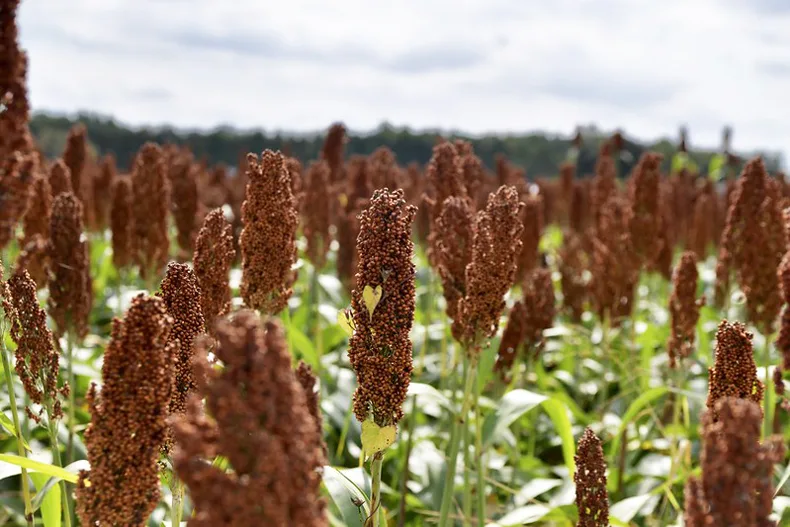What Is Sorghum? A Look at an Essential African Grain

In the world of native African grains, the significance of sorghum spans centuries and borders, widely scattered around the continent like the seeds from which it comes. But what is sorghum, exactly, and how is it used in Africa?
Sorghum is an ancient, nutrient-packed, relatively drought-resistant cereal grain. It is used for food (as a whole grain, ground into meal, and as a sweetener, like molasses), in the production of alcoholic drinks, for animal feed, and for biofuels. It’s naturally gluten-free, packed with antioxidants, and is high in fiber, protein, iron, potatassium, calcium, and other essential nutrients. In some countries, like my own South Africa and large swathes of northeast and northwest Africa, sorghum is brewed into a traditional beer. It’s eaten in a porridge served for special occasions in some countries, like Botswana. In East Africa, its harvested grains are wrought with import for two ethnic groups.
The common thread? Sorghum is key to ancestral, religious, and culinary traditions passed down over centuries across Africa—traditions fast fading away in modern African life.
Here’s a look at the importance of sorghum, and its many uses, in a number of African countries.

Sifting sorghum in Ethiopia (courtesy of Rod Waddington/Flickr)
“Three indigenous African grain crops—millet, sorghum, and teff—made the transition from wild grasses to domesticated food at the hands of Africans who collected seed grains of local wild grasses as food, planted the best of those grains as seed, and continued over generations to select from those domesticated grains the characteristics that best suited their tastes and farm ecologies.” —James C. McCann, Stirring the Pot: A History of African Cuisine

Umqombothi in South Africa (courtesy of SpesBona/Wikimedia Commons)
Sorghum in South Africa
In South Africa, a traditional beer is brewed from sorghum, known as umqombothi in isiZulu (one of the 11 official languages in South Africa). It has a sour aroma, a creamy consistency, and an opaque pinkish color. Umqombothi is usually consumed at cultural ceremonies such as initiation-school graduation celebrations and African festivals such as dikgafela. We also use it when we pray for rain, when we communicate with ancestors (amadlozi), at wedding celebrations, at funerals, at lobola (dowry) ceremonies, and when we celebrate the birth of a child in the family.
The matriarchs in our families are the brewers of the sorghum beer, using their self-taught brewing techniques: Our grandmothers would just use bowls, cups, or their hands to gauge the measurements of the ingredients. No wonder the beer would taste different from one household to the other despite the brewing process being the same!
Apart from being an integral part of spiritual and cultural ceremonies in our country, umqombothi was long a source of income for some households in rural areas. My great-grandmother was one of those matriarchs who put food on the table by selling traditional sorghum beer. Old men from around the village where she resided would gather at her yard and socialize over a calabash of umqombothi. She was one of the few elderly women in her village who was a master at brewing “tasty” traditional beer.
In some African families, the brewing process of umqombothi is passed down from one generation to the other, but that wasn’t the case for me, unfortunately. There are pre-packaged mixtures available at the shops under various brand names—but it doesn’t change the fact that this brewing legacy is slowly disappearing as people move to urban areas, away from the rural areas where the tradition was born.

Sorghum-based lager beer in Tanzania (courtesy of Alina/Flickr)
Sorghum in Botswana
In Botswana, there’s a harvest ceremony called dikgafela in Setswana. It was traditionally held to thank the ancestors (badimo) for the rain that watered their crops after the dry winter season, and beer made with—you guessed it—sorghum was the ancestral offering. Batswana women would take part of their harvest to the kgosi, or king (the chief of the tribe), in clay pots. The harvested grains were usually stored at the kgotla, the traditional law court, and were intended to feed the poor during difficult times. The grains (usually sorghum) were stored at a central warehouse (difalana) under the supervision of the king. The offerings of sorghum were also accompanied by some ancestral healing or cleansing (phekolo) ceremonies. This video shows some photos of a dikgafela ceremony dating back a few decades.
Today, dikgafela is still celebrated in some parts of Botswana, while others have outgrown the festival. Sorghum is mostly used in ceremonial dishes only.

Drying sorghum in Uganda (courtesy of Kent MacElwee/Flickr)
Symbolism of Sorghum in East Africa
In certain parts of Uganda and Kenya, there are two ethnic groups known as the Jie and the Turkana people, both of whom treat sorghum with utmost respect. The Jie people are part of the Paranilotic-speaking community who migrated to the Northern Karamojong Plateau because of environmental pressures from the Dongiro region of southwestern Ethiopia around 1500 CE. The introduction of sorghum farming to the Jie people by the Acholi agriculturalists in the early years of the 17th century brought into existence the Turkana ethnic group. The Turkana ultimately broke away from Jie society and moved to their current home in the grasslands of Turkana in northern Kenya.
For the Jie people, sorghum is not only the main part of their diet—it’s also seen as a gift from their deities and ancestors. The ethnic group had a unique sorghum harvesting ceremony that was more about exchanging gifts than about eating and tasting. The ceremony, the harvesting, and the exchange of sorghum between the Turkana and the Jie women embodied not only the values and wealth of the two ethnic groups, but also the acknowledgment of the interethnic history between them. During harvest season, the women of the Turkana ethnic group would roam around in the Jie communities, helping the women of the Jie ethnic group fetch firewood, brew beer, and grind grains in anticipation of receiving the sorghum grains of the Jie women.
The activities of the Jie harvest ceremony were symbolic of how the social powers of women were advanced in a patriarchal society through the giving of sorghum grain. For the Turkana and Jie people the sorghum crop symbolized their ancestors and their gods, and the harvest ceremony promoted the renewal of kinship through the exchange of sorghum.

A Dassanech woman grinds sorghum in Ethiopia (courtesy Rod Waddington/Flickr)
The Jie and Turkana people also used sorghum to demonstrate peace between them. Ethnic clashes often arose between the two groups because Jie men would occasionally steal the cattle of the Turkana. In such instances, the Jie women would offer sorghum to the Turkana women in the name of Nayeche, an ancestor the two groups share. The Turkana women would then use the sorghum they received as a peace offering to brew beer, and the two ethnic groups would meet and drink the sorghum beer together to symbolize their peace. The sorghum offering was a paramount cultural rite in which the two groups celebrated the symbolic return of Nayeche.
Nowadays, the Jie harvest ceremony has changed and become more complicated due to modern commercial farming and the planting of different sorghum grains. The new and changing notions around society and ethnicity have infiltrated the Jie community through foreign development agencies, anthropologists, missionaries, and governments, and it’s altered the way the harvest ceremony is now celebrated. Seed harvesting used to be done by hand, by women, and a mortar and pestle were the tools used for grinding and mixing the grains. Today, modern machinery does the harvesting and sorghum seeds themselves have been commercialized.

Sorghum porridge (courtesy of Jon Mountjoy/Flickr)
Sorghum as Ceremonial Dish
In Botswana and some parts of South Africa there is a traditional signature dish made with sorghum known as ting ya mabele, a fermented porridge made by boiling the sorghum meal. In the old days, the porridge was an everyday dish for our great-grandparents, eaten with milk, meat, or vegetables, but the dish has evolved to become ceremonial food today, served at weddings, funerals, and other special ceremonies. Ting ya mabele, or ting for short, is used to pay homage to the ancestors, who hardly ever ate the white mealie meal (i.e., milled white maize) that’s replaced ting in many households. When people eat ting, the ancestors are reminded that they are not forgotten, and they’re included in the event taking place.
For many people, the taste of ting ya mabele reminds them of home. Urbanites have been known to travel from the innermost parts of a city to the rural areas to attend a funeral or wedding in the hope of getting a plate of ting and beef or chicken.
The Decline of Sorghum in African Cuisine
According to James McCann in Stirring the Pot: A History of African Cuisine, sorghum porridges were largely replaced with maize, a New World grain, in many regions during the 20th century. Breads made from sorghum (and other gluten-free grains) were unleavened, and also, around the same time, became less popular among the African urban elite who had adopted wheat bread.
Sorghum beer, meanwhile, has suffered from the increasing trend of Africans abandoning rural areas (and traditions) for urban one. Additionally, as McCann points out, the arrival of Islam, which forbids alcohol, to countries like Egypt, Sudan, eastern and northeastern Ethiopia, northern Nigeria, Niger, Mali, Chad, and Burkina Faso, has played a role in the decline of the sorghum crop.
So what’s next for sorghum? Will there be a renewal of traditions, or will it be a forgotten grain? Only time will tell.

PIN to save for later!
About the author: Laurika Nxumalo is a freelance writer in academia. She`s also a columnist and blogger. Laurika finds cooking very therapeutic.
Featured image (sorghum grains in a field) courtesy of Michele Dorsey Walfred/Flickr
Last updated: Jan. 23, 2024



Amazing information. This grain Sorghum is a grain of Africa used to make beer for centuries. Thanks for posting these pictures. Your hard work is really making the world a smaller place connecting the people at least digitally and letting us know about such hidden and amazing things in the world.
Thanks so much for reading!
Appreciated reading and learning about sorghum. I knew the name and recently a pound came into my kitchen.
Tonight 2 birthdays are being celebrated African potluck which l am to bring a salad for. Your article did not provide the needed recipe but information will be shared. I particularly liked learning the making of beer was a matriarch contribution that GOT passed down.
So happy this piece provided some context for you! How did you prepare the sorghum?
Please, be respectful of black and brown women. When westerners share photos of rural folk, please fade out women’s breast and men’s buttocks when in western publications. It is disrespectful to show her breasts to a culture that does not display their women’s breast or manly parts in society. Just think about it. Just because it is just nature to THEM, it is not proper in our world and therefore should be the same dignity our culture would require.
Thank you for your response. We considered the image you refer to photojournalism in capturing a way of life in regards to the sorghum grain. However, we went ahead and cropped the image in question, as we’d hate for this piece to be interpreted as disrespectful in any way. We hope you otherwise enjoyed the article.